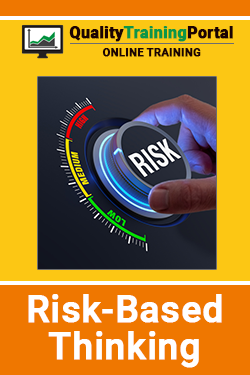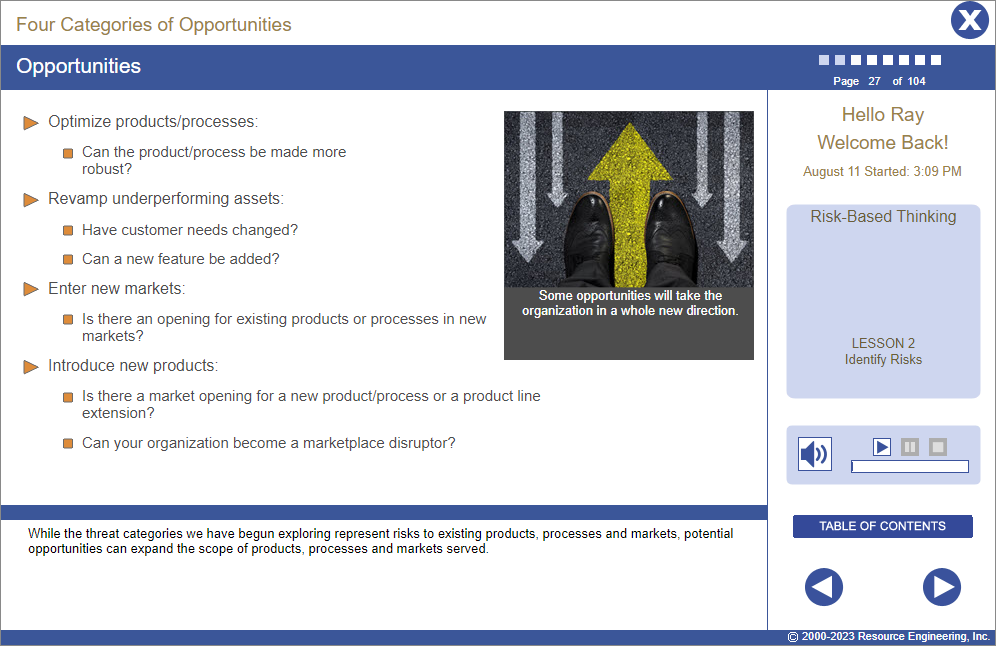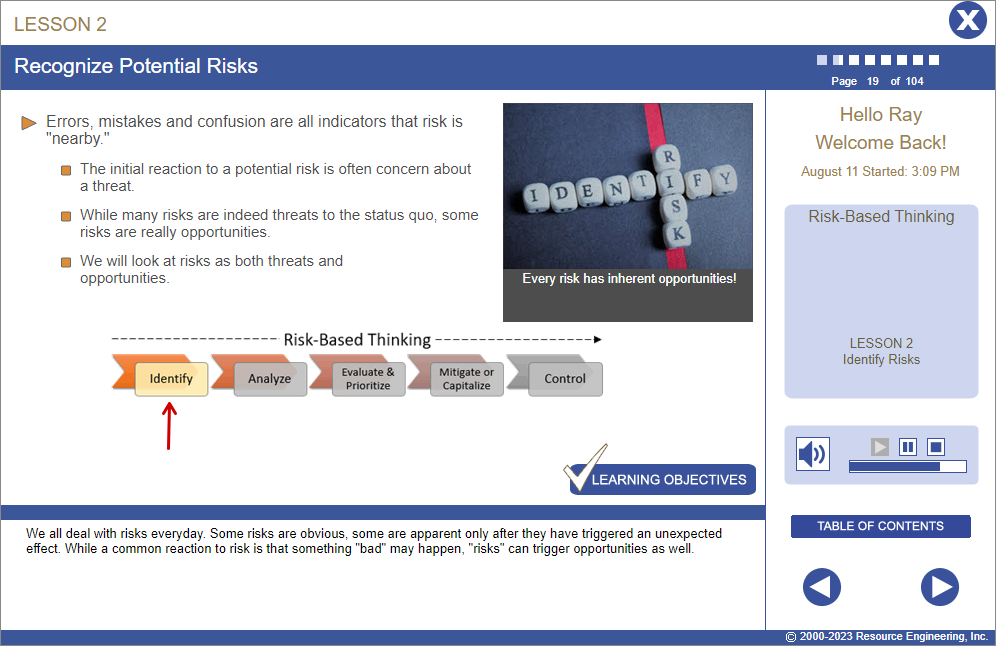Course Information
Risk-Based Thinking Training
Learners will be able to:
- Identify, assess, and evaluate potential risks.
- Prioritize risk targets, initiate action and track mitigation efforts.
- Establish a comprehensive risk management process.

About This Course
What is Risk-Based Thinking?
Both industry-wide and industry-specific standards have incorporated risk-based thinking into their requirements. Some standards call for assessing risk levels and taking action to deal with risks that are identified, others call for organizations to define risk management protocols. But, in all cases, the underlying premise of risk-based thinking is that organizations should always factor in risks as they develop plans, review business results and take corrective action. The intent is for the organization to identify the risk, decide what (if any) action is required and then act.
Risk-Based Thinking Training Online
Risk-Based Thinking training teaches learners how to develop and conduct a risk management process in seven lessons. The initial lesson highlights industry standards that now incorporate risk-based thinking. The next five lessons lead learners through the five phases of risk-based thinking. The final lesson in the course explores a sample risk management process complete with forms to track and document risks identified and mitigated (if they are unacceptable threats) or identified and capitalized upon (if they are worthwhile opportunities).
Our Risk-Based Thinking training course is a cost-effective and flexible way to get your entire team up to speed on Risk-Based Thinking without time-consuming off-site seminars or expensive in-house training. Learners take the training when it fits into their schedule and everyone learns the same concepts and terminology in the same way. When you purchase one of our subscriptions, you have full administration of your training and can assign courses, monitor results and use our follow-up reminders to assure everyone completes the training on time. Reports and certificates provide the documentation of training completed that is often needed for audits.
- None.
- English (EN-US)
- Chinese (simplified) (ZH)
- Czech (CS)
- French (FR)
- German (DE)
- Italian (IT)
- Japanese (no audio) (JA)
- Korean (no audio) (KO)
- Polish (PL)
- Portuguese (Brazilian) (PT-BR)
- Romanian RO)
- Russian (RU)
- Spanish (ES)
- Vietnamese (no audio) (VI)
Course Objectives
- Identify, assess and evaluate potential risks (whether they are threats or opportunities).
- Prioritize potential targets.
- Gain insight on how to develop action plans for high priority targets.
- Measure and track the effectiveness and progress of action taken.
- Initiate control plans to curb similar risks in the future.
- Establish a comprehensive risk management process.
Course Outline
Lesson 1 | Risks and Quality Standards
- Understand that some standards have been revised and now incorporate risk-based thinking into their requirements.
- Be exposed to several industry-wide and industry-specific standards that call for risk-based thinking.
Lesson 2 | Identify Risks
- Recognize potential risks that signal threats.
- Realize that a potential risk may be an opportunity, not a threat.
- Be familiar with common tools to identify threats and opportunities.
Lesson 3 | Analyze Risks
- Know how to analyze the Likelihood of a potential threat or opportunity.
- Rate the Impact of an event.
- Plot the Likelihood versus the Impact on a 2-D Matrix.
Lesson 4 | Evaluate & Prioritize Risks
- Calculate the Risk Index using the ratings for Likelihood and Impact from the “Analyze Risks” phase.
- Use the Risk Index to set priorities for action plans to reduce the risk from threats and capitalize on favorable opportunities.
Lesson 5 | Mitigation or Capitalization
- Understand how to mitigate unacceptable threats.
- Be aware of strategies to capitalize on worthwhile opportunities.
Lesson 6 | Control Risks
- Be familiar with some common measures and control mechanisms that help ensure that risk mitigation continues to work as planned and that gains made are sustained.
Lesson 7 | Risk Management
- Realize that Risk-Based Thinking can lead to a comprehensive Risk Management Process.
- Be aware of forms that can support the methodology needed for a Risk Management Process.
- Understand how the Summary Worksheet serves as both an historical document and a communication tool.
Challenge
- An assessment of the learner’s progress in this course.

4.5 out of 5 stars
Comments from Learners About This Course
- Very good training. Easy to follow along.
- Good description of techniques and the importance to have risk-based thinking.
- Very good and informative. I have a much better understanding of Risk Based Thinking.
- I liked that the course could be made relatable to a variety of departments such as Risk Opportunities relating to commercial / NPD / Technical departments.
You may also be interested in…
- Mistake-Proofing Training – Comprehensive online training in poka yoke/mistake-proofing techniques for manufacturing operations.
- 8D Problem-Solving – Step-by-step training in how to work on a problem-solving team follow the 8D methodology including tools and techniques that are used in each step.
- Root Cause Analysis with Corrective Action – Leads the learner through a four-step process to get to the root cause (source) of problems to eliminated problems for good.




